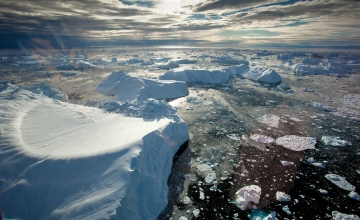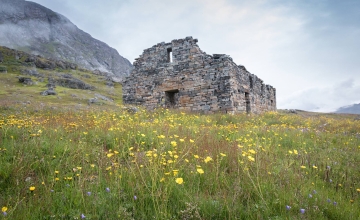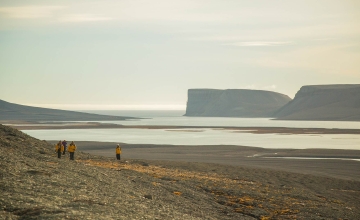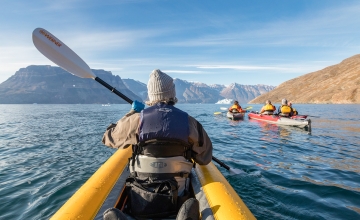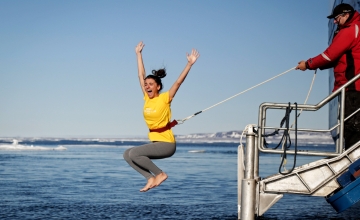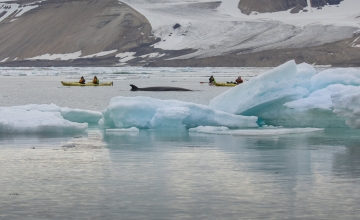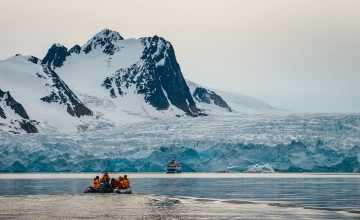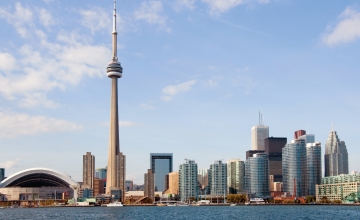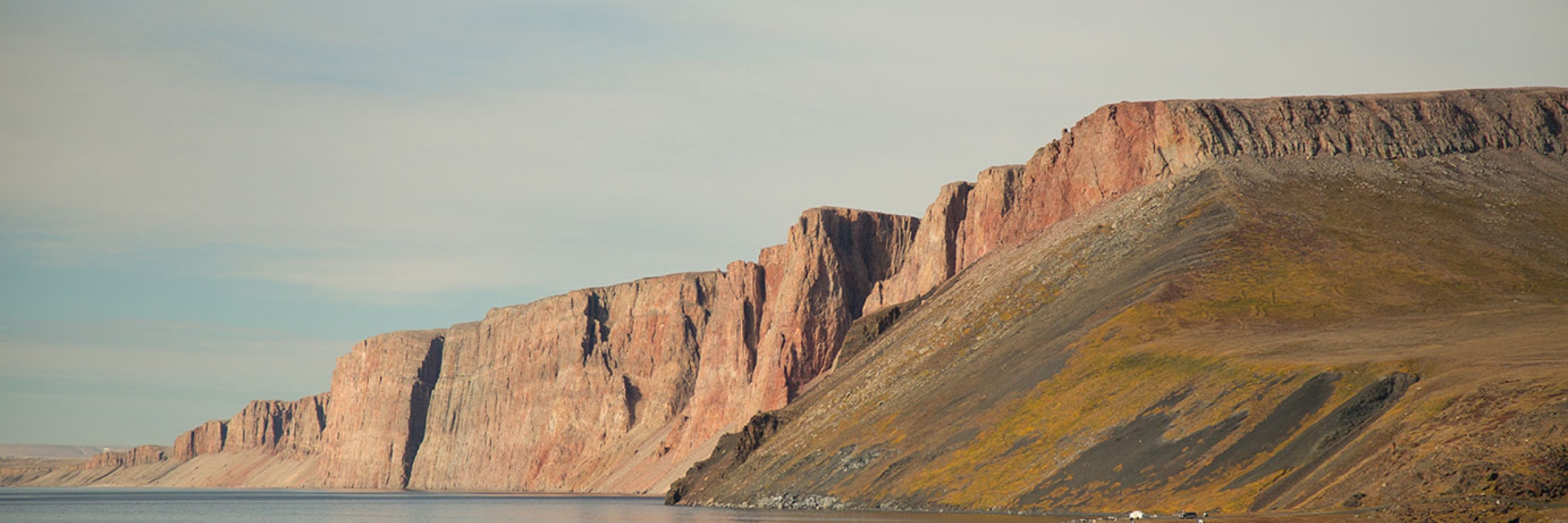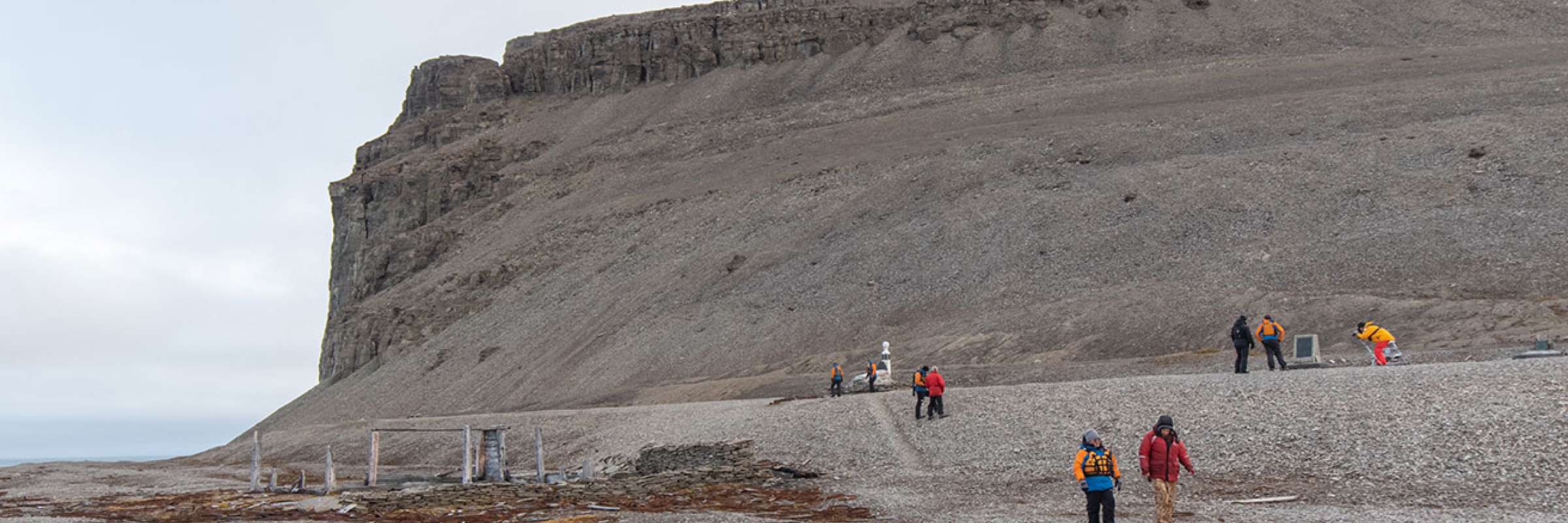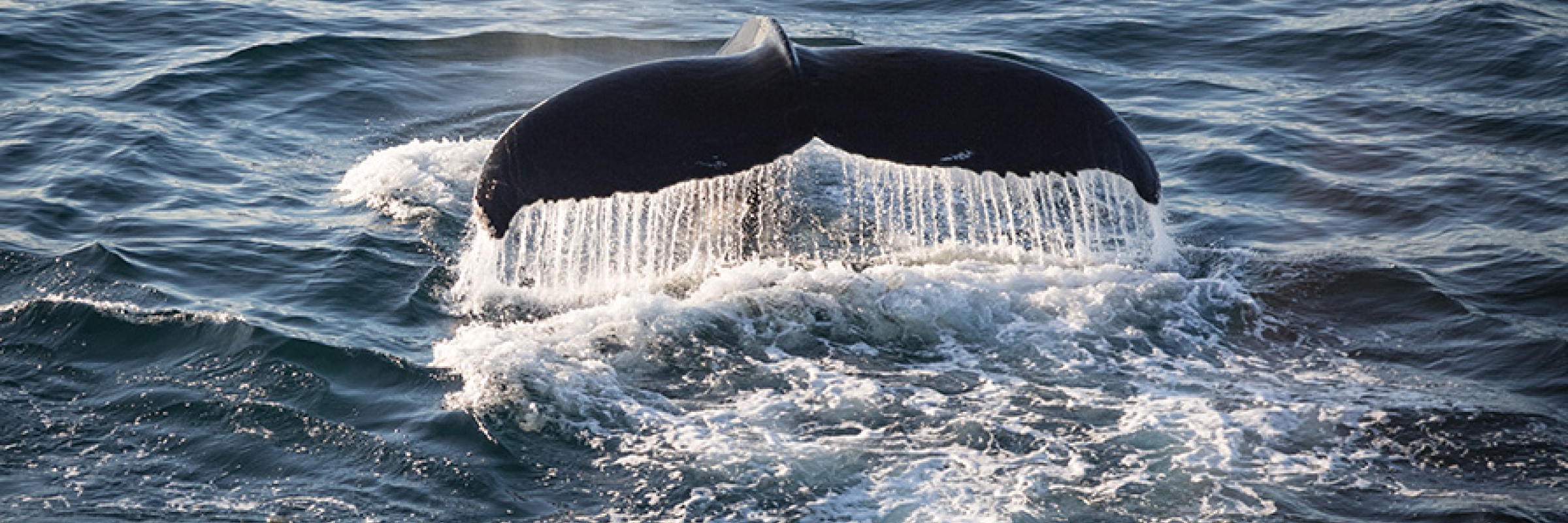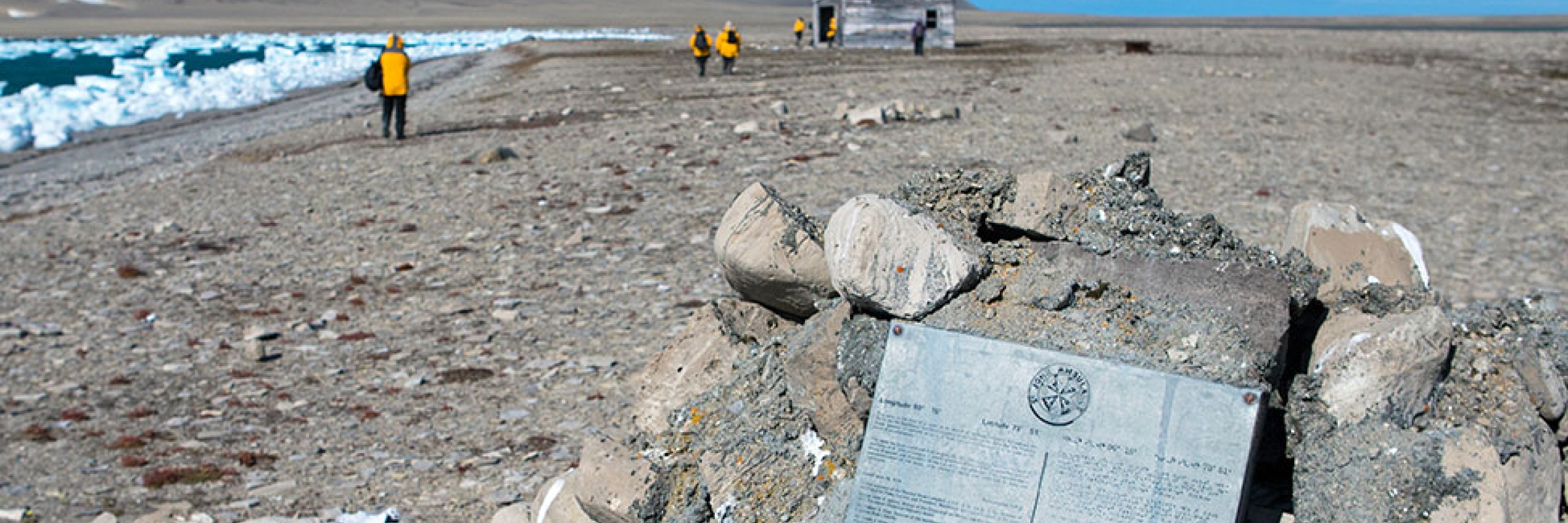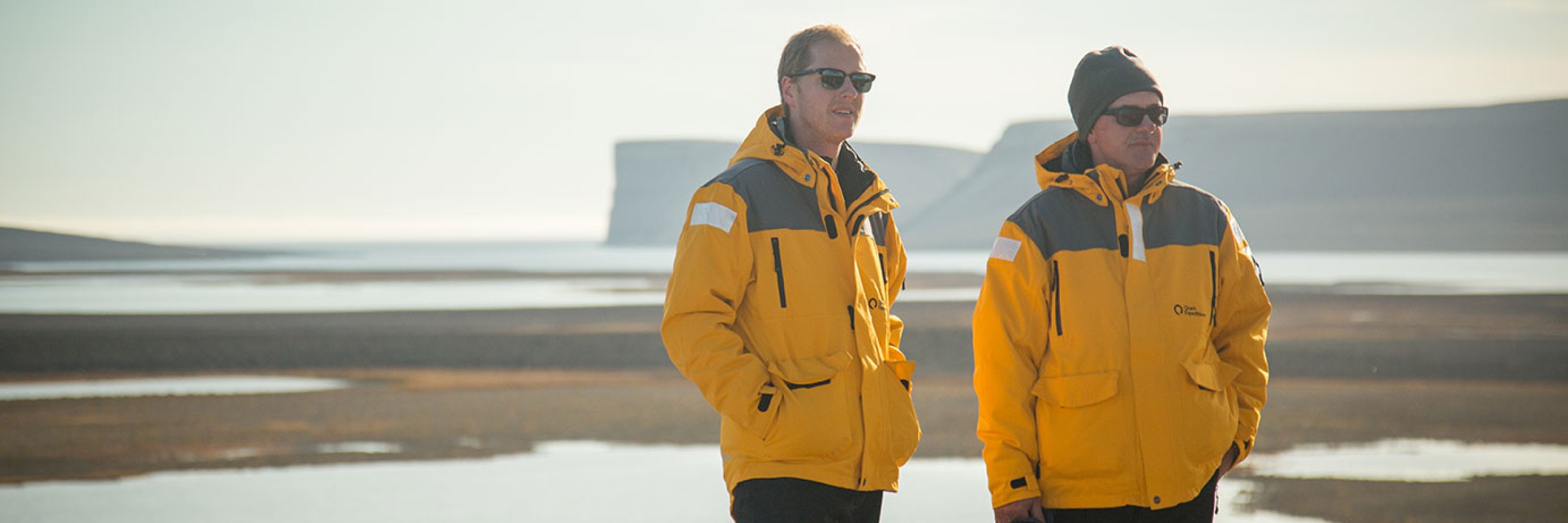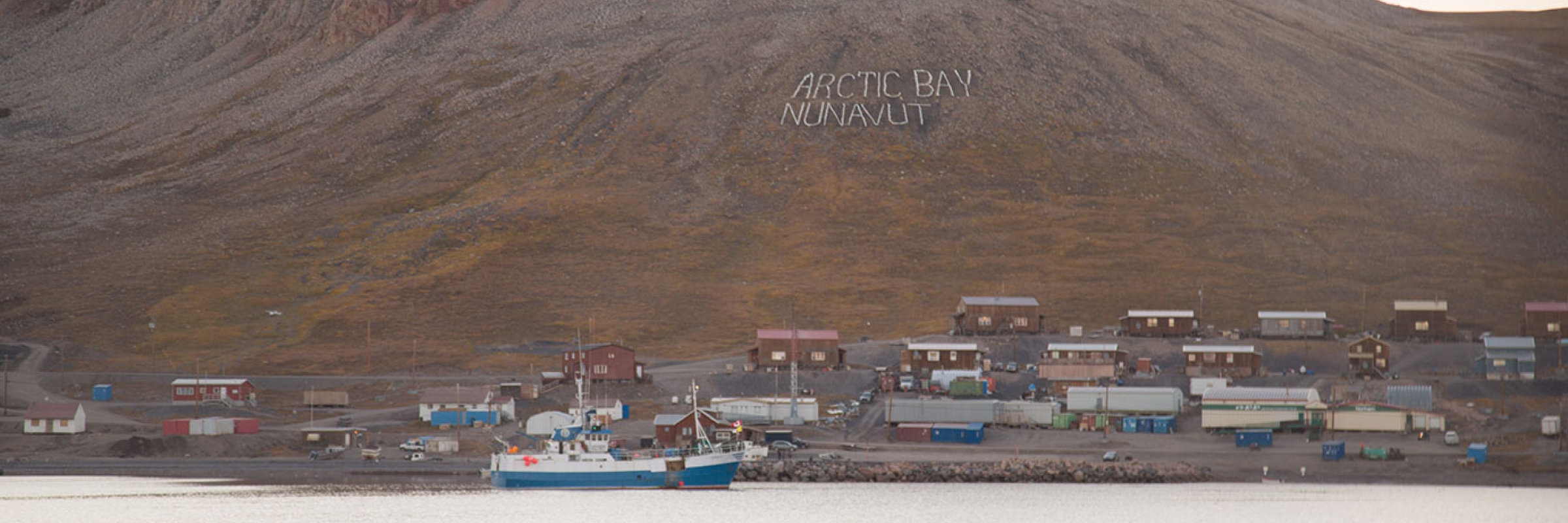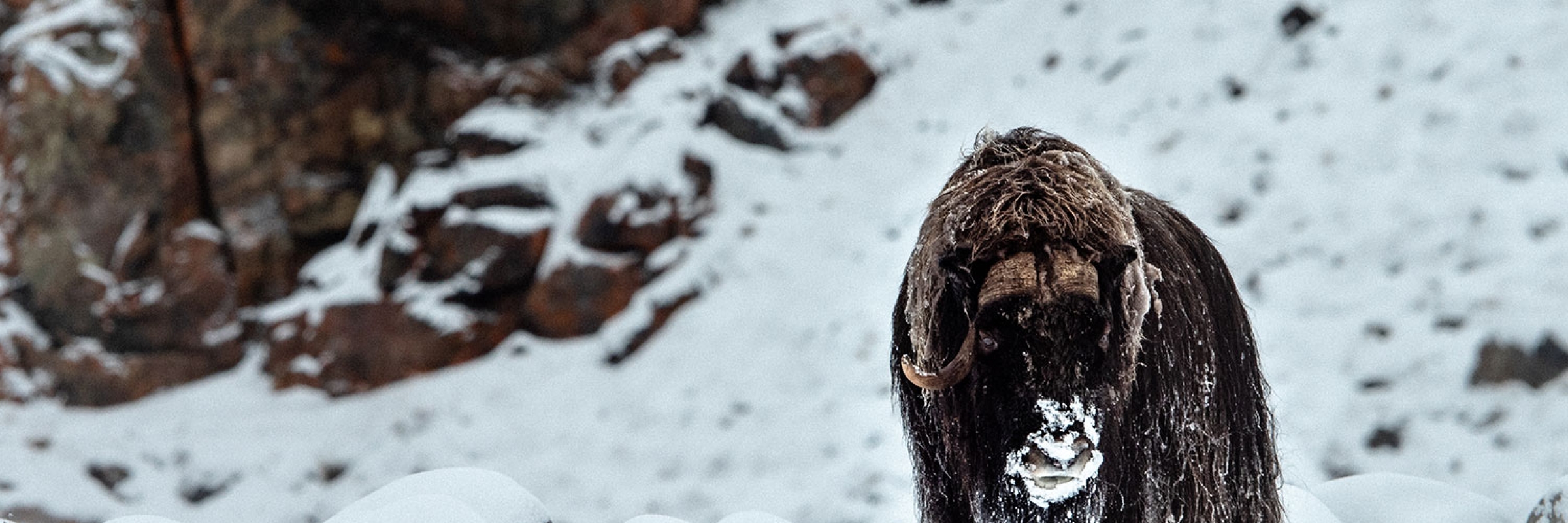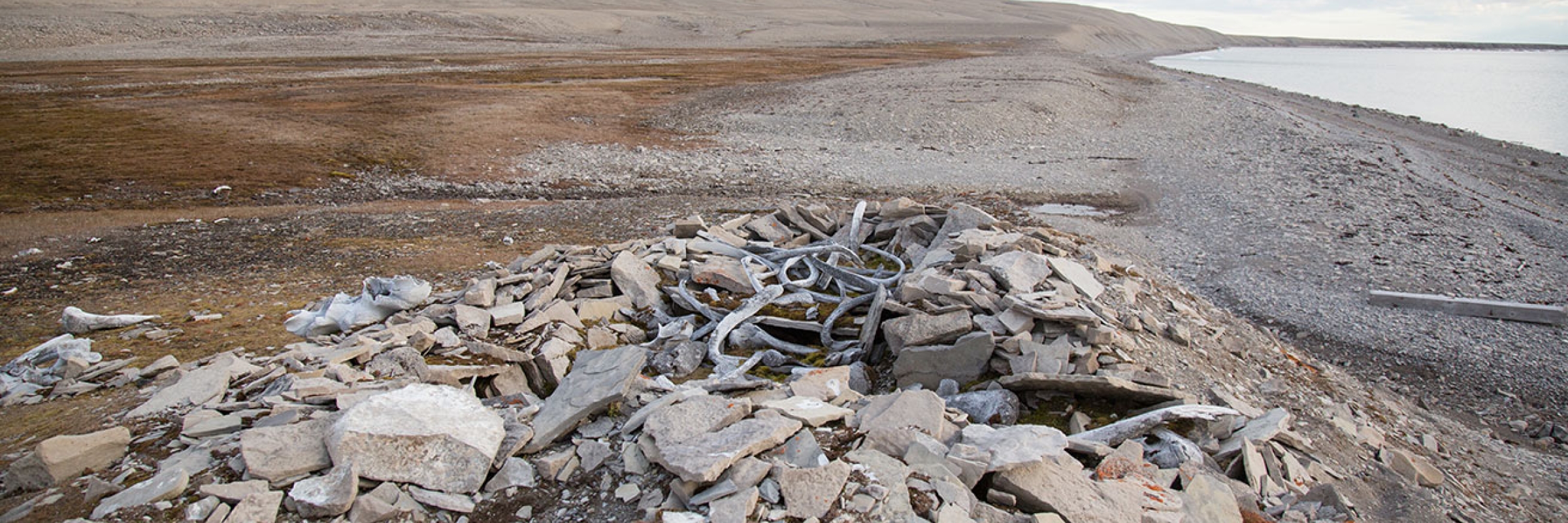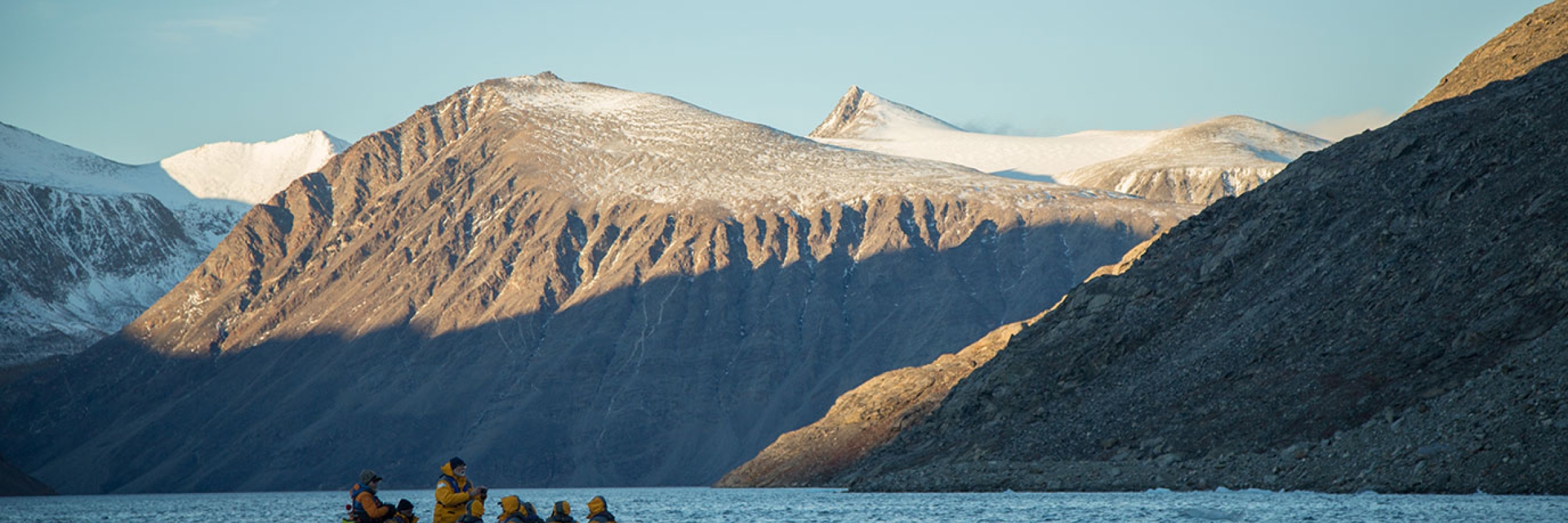Your Arctic expedition begins in Toronto. Explore this vibrant city on your own before spending the night enjoying the comfort and amenities of your designated hotel.
Arctic Express Canada: The Heart of the Northwest Passage
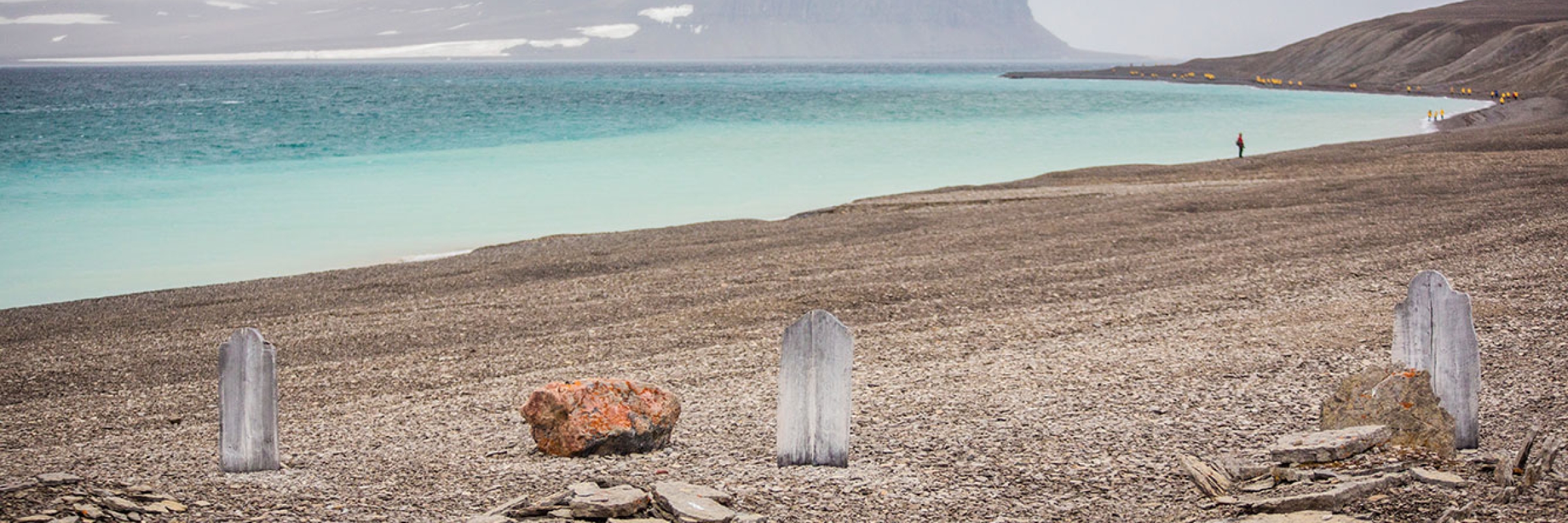
The quest for trade routes to the Far East inspired much of the age of exploration of North America, with the promise of the Northwest Passage its elusive jewel. On Arctic Express Canada, discover the great sea route at the top of the world—that obsessed explorers for centuries—on our game-changing new expedition ship Ultramarine, which allows you a journey no traditional vessel could offer: immersing yourself in the full Arctic experience while getting back home a week and a half later.
Nature and wildlife are the guides on this voyage as you explore the region’s diverse treasures. The Arctic’s stark beauty offers an unforgettable backdrop, while Quark Expeditions’ world-class team provides the knowledge and insight to help you connect with the region’s unique history and geography. Ultramarine’s two twin-engine helicopters, 20-quick-launching Zodiacs and unprecedented mix of on-ship amenities and off-ship adventure options will deliver an unrivalled Arctic experience no one else can.
- Follow the footsteps of polar explorers and experience highlights of the Canadian Arctic
- Search for iconic Arctic wildlife such as polar bears and muskox
- Enjoy flightseeing and heli landings with Ultramarine’s two onboard helicopters
- Cruise in a Zodiac to get up close to glaciers, fjords, icebergs and more
- Learn about the environment and wildlife from our onboard polar experts
行程
Day 1 — Arrive in Toronto, Canada
Day 2 — Fly to Resolute and Embark
This morning, board your charter flight to Resolute, Nunavut. Upon arrival, you will be transferred to your ship via Zodiac or helicopter (depending on ship location and weather conditions).
Days 3 to 7 — Exploring Canada’s High Arctic
Winding your way around the remote islands of the Canadian High Arctic aboard Ultramarine, the newest ship in our fleet, you’ll navigate the same icy inlets, channels and bays that fascinated legendary explorers of long ago as they searched for the fabled Northwest Passage, the great sea route at the top of the world. Designed to give polar adventurers unprecedented access to the hardest-to-reach places on the planet—and equipped with two onboard twin-engine helicopters for unparalleled access to areas only Quark Expeditions can bring you—this one-of-a-kind ship will take you beyond the familiar in polar exploration. Throughout your journey, your Expedition Team will work hard to give you a taste of the best the Canadian Arctic has to offer, immersing you in the heart of the Northwest Passage in under a week.
While this waterway is known to European cultures as the Northwest Passage, these lands and waters have nurtured and sustained the Inuit and their predecessors who have called these shores home for almost 5,000 years. Moving through these remote landscapes you will be traveling through the ancestral homelands of this ancient culture, illuminated by Inuit guides onboard and ashore. Nunavut is an Inuktitut word meaning “our land” and the Nunavummiut (the people of Nunavut) are renowned for their incredible resourcefulness, hospitality, good humor, and a deep knowledge of the land and animals that has allowed them to thrive in the far north for millennia.
Remote and rich in history, the Canadian High Arctic is as awe inspiring as it is informative. Your days spent exploring this mysterious region will have you traveling back in time to the Age of Exploration. While following in the footsteps of famous explorers like Sir John Franklin and Roald Amundsen, you’ll navigate the waters and visit the historic sites in the area around Lancaster Sound that were key to the discovery of the Northwest Passage. You’ll also learn about the scientific, cultural, geopolitical and environmental aspects of the route from our world-class experts, guides and the local communities. Reaching remote lands that have lured adventurers for centuries will be an experience you’ll never forget.
Wildlife sightings are almost guaranteed, as many of the areas we hope to explore are home to a surprising number of birds and mammals that thrive in this challenging environment. You may see polar bears, muskoxen and several bird species, such as gyrfalcons and dovekies (little auks). If you’re lucky, you may even spot the elusive narwhal or a bowhead whale, though sightings of these iconic creatures in the wild are rare, even in places where we have the greatest chances of encountering them.
Coburg Island, for instance, is a wildlife reserve for such birds as snowy owls and peregrine falcons, while the impressive vertical cliffs of Prince Leopold Island are dotted with nesting seabirds like northern fulmars and black guillemots. The sheltered shores and steep cliffs of Arctic Bay, a hamlet located in Admiralty Inlet, provide an ideal nesting habitat for various High Arctic birds such as thickbilled murres (Brünnich’s guillemots) and kittiwakes. This community, whose inhabitants’ ancestors have lived a traditional Inuit nomadic lifestyle in the region for almost 5,000 years, is also an ideal spot to go ashore and learn more about the Inuit culture, sampling the local cuisine and mingling with artists, perhaps picking up carvings or other handicrafts as a memento of your polar adventure.
Devon Island is another possible locale for wildlife encounters, as walrus, polar bears and muskoxen inhabit the area, which is also the location of the remains of a Royal Canadian Mounted Police outpost, established at Dundas Harbour in 1924 to curb foreign whaling and other activities. Here you’ll find a small cemetery, one of Canada’s most northerly, still maintained by the RCMP to this day. Another exciting excursion your Expedition Team might offer, conditions permitting, is the opportunity to fly up to explore the Devon ice cap, one of the largest in the Canadian Arctic.
At the western end of Devon Island, windswept Beechey Island might be small, but it’s steeped in history, as its broad shore and safe anchorage made a suitable stopover for Arctic expeditions. You’ll want to pay your respects to the ill-fated Franklin expedition of 1845–46 at the small marked graves of three crew members on the island, one of Canada’s most significant historical sites. This is also where Norwegian Roald Amundsen stopped to pay his own respects to his childhood hero, Franklin, during his 1903–06 voyage, which became the first successful transit of the Northwest Passage.
History buffs will be further intrigued by the chance to explore an abandoned Hudson’s Bay Company trading post at Fort Ross, at the southern end of Somerset Island.
Fort Ross is at the eastern entrance of Bellot Strait. One of the goals of this expedition is to transit this famous channel, one of the most narrow and challenging of the passage. If we’re successful, at the midpoint you’ll sail past Zenith Point, the northernmost point of continental North America. Named for Frenchman Joseph Bellot, one of several explorers who set out in the 1850s to search for Franklin’s doomed expedition, the strait separates Somerset Island from the Boothia Peninsula on mainland Canada. (On Beechey Island, you can visit the memorial to Bellot, who disappeared during his search for Franklin.)
Those looking for even more excitement may have the opportunity to cruise by Zodiac along the face of an active glacier near Croker Bay, Devon Island and possibly even witness the wonder of calving ice, at a safe distance. Listen closely for the steady crackle and loud roars as pieces of ice break off and crash into the water below. You’ll also want to be on the lookout for the walrus that are often seen in the area.
There is no shortage of natural beauty, wildlife and history in Canada’s High Arctic. Each day, you’ll discover something new and inspiring, whether it is admiration of the tundra flora that survive here, a rare bird species soaring overhead, a polar bear on the hunt in its natural habitat, or the ancient remains of a Thule dwelling, ancestors of the Inuit.
Remember that no two polar voyages are alike, since each expedition presents new opportunities and different weather and ice conditions. While this voyage has no fixed itinerary, our objective is to visit as many of the incredible highlights the season has to offer, using the opportunities provided by the weather and ice to give you the best experience. Each day, your highly skilled Expedition Team will read the conditions and choose the best course to set, but despite their extensive expertise in these areas, each visit brings something new to discover. That said, our expeditions will have some elements in common, including daily Zodiac cruising, land excursions, a robust education program, a community visit and wildlife viewing opportunities. And thanks to our onboard helicopters, you’ll also discover the ultimate polar expedition experience: as stunning as polar landscapes are from your ship, they’re even more striking from the air! Conditions permitting, you’ll enjoy ultra-immersive activities like flightseeing (short sightseeing flights around your ship and surrounding areas) and helilandings (flying to places we could not otherwise access), two breathtaking options that are unique to Ultramarine and give you an exhilarating polar experience like no other.
Day 8 — Disembark in Resolute, Canada and Fly to Toronto
After disembarking in the Inuit hamlet of Resolute, you’ll be transferred to your charter flight to Toronto, where you’ll spend the night at your included hotel.
Day 9 — Depart Toronto
Today, make your way to the airport to catch your homeward flights, or spend the day exploring this fascinating city.
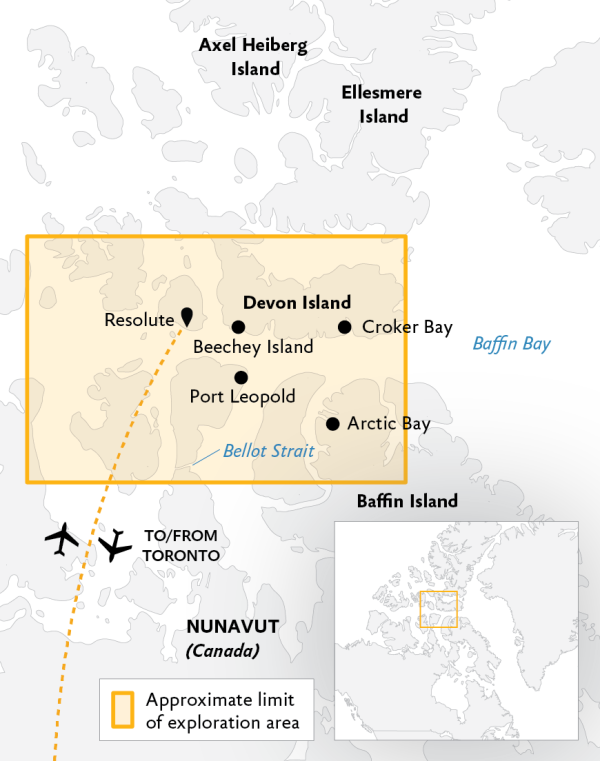
Day 1 — Arrive in Toronto, Canada
Your Arctic expedition begins in Toronto. Explore this vibrant city on your own before spending the night enjoying the comfort and amenities of your designated hotel.
Day 2 — Fly to Resolute and Embark
This morning, board your charter flight to Resolute, Nunavut. Upon arrival, you will be transferred to your ship via Zodiac or helicopter (depending on ship location and weather conditions).
Days 3 to 7 — Exploring Canada’s High Arctic
Winding your way around the remote islands of the Canadian High Arctic aboard Ultramarine, the newest ship in our fleet, you’ll navigate the same icy inlets, channels and bays that fascinated legendary explorers of long ago as they searched for the fabled Northwest Passage, the great sea route at the top of the world. Designed to give polar adventurers unprecedented access to the hardest-to-reach places on the planet—and equipped with two onboard twin-engine helicopters for unparalleled access to areas only Quark Expeditions can bring you—this one-of-a-kind ship will take you beyond the familiar in polar exploration. Throughout your journey, your Expedition Team will work hard to give you a taste of the best the Canadian Arctic has to offer, immersing you in the heart of the Northwest Passage in under a week.
While this waterway is known to European cultures as the Northwest Passage, these lands and waters have nurtured and sustained the Inuit and their predecessors who have called these shores home for almost 5,000 years. Moving through these remote landscapes you will be traveling through the ancestral homelands of this ancient culture, illuminated by Inuit guides onboard and ashore. Nunavut is an Inuktitut word meaning “our land” and the Nunavummiut (the people of Nunavut) are renowned for their incredible resourcefulness, hospitality, good humor, and a deep knowledge of the land and animals that has allowed them to thrive in the far north for millennia.
Remote and rich in history, the Canadian High Arctic is as awe inspiring as it is informative. Your days spent exploring this mysterious region will have you traveling back in time to the Age of Exploration. While following in the footsteps of famous explorers like Sir John Franklin and Roald Amundsen, you’ll navigate the waters and visit the historic sites in the area around Lancaster Sound that were key to the discovery of the Northwest Passage. You’ll also learn about the scientific, cultural, geopolitical and environmental aspects of the route from our world-class experts, guides and the local communities. Reaching remote lands that have lured adventurers for centuries will be an experience you’ll never forget.
Wildlife sightings are likely, as many of the areas we hope to explore are home to a surprising number of birds and mammals that thrive in this challenging environment. You may see polar bears, muskoxen and several bird species, such as gyrfalcons and dovekies (little auks). If you’re lucky, you may even spot the elusive narwhal or a bowhead whale, though sightings of these iconic creatures in the wild are rare, even in places where we have the greatest chances of encountering them.
Coburg Island, for instance, is a wildlife reserve for such birds as thick-billed murres (Brünnich’s guillemot), black-legged kittiwakes, northern fulmars and black guillemots, while the impressive vertical cliffs of Prince Leopold Island are dotted with nesting seabirds like northern fulmars and black guillemots. The sheltered shores and steep cliffs of Arctic Bay, a hamlet located in Admiralty Inlet, provide an ideal nesting habitat for various High Arctic birds such as thick-billed murres (Brünnich’s guillemots) and kittiwakes. This community, whose inhabitants’ ancestors have lived a traditional Inuit nomadic lifestyle in the region for almost 5,000 years, is also an ideal spot to go ashore and learn more about the Inuit culture, sampling the local cuisine and mingling with artists, perhaps picking up carvings or other handicrafts as a memento of your polar adventure.
Devon Island is another possible locale for wildlife encounters, as walrus, polar bears and muskoxen inhabit the area, which is also the location of the remains of a Royal Canadian Mounted Police outpost, established at Dundas Harbour in 1924 to curb foreign whaling and other activities. Here you’ll find a small cemetery, one of Canada’s most northerly, still maintained by the RCMP to this day. Another exciting excursion your Expedition Team might offer, conditions permitting, is the opportunity to fly up to explore the Devon ice cap, one of the largest in the Canadian Arctic.
At the western end of Devon Island, windswept Beechey Island might be small, but it’s steeped in history, as its broad shore and safe anchorage made a suitable stopover for Arctic expeditions. You’ll want to pay your respects to the ill-fated Franklin expedition of 1845–46 at the small marked graves of three crew members on the island, one of Canada’s most significant historical sites. This is also where Norwegian Roald Amundsen stopped to pay his own respects to his childhood hero, Franklin, during his 1903–06 voyage, which became the first successful transit of the
Northwest Passage.
History buffs will be further intrigued by the chance to explore an abandoned Hudson’s Bay Company trading post at Fort Ross, at the southern end of Somerset Island.
Fort Ross is at the eastern entrance of Bellot Strait. One of the goals of this expedition is to transit this famous channel, one of the most narrow and challenging of the passage. If we’re successful, at the midpoint you’ll sail past Zenith Point, the northernmost point of continental North America. Named for Frenchman Joseph Bellot, one of several explorers who set out in the 1850s to search for Franklin’s doomed expedition, the strait separates Somerset Island from the Boothia Peninsula on mainland Canada. (On Beechey Island, you can visit the memorial to Bellot, who disappeared during his search for Franklin.)
Those looking for even more excitement may have the opportunity to cruise by Zodiac along the face of an active glacier near Croker Bay, Devon Island and possibly even witness the wonder of calving ice, at a safe distance. Listen closely for the steady crackle and loud roars as pieces of ice break off and crash into the water below. You’ll also want to be on the lookout for the walrus that are often seen in the area.
There is no shortage of natural beauty, wildlife and history in Canada’s High Arctic. Each day, you’ll discover something new and inspiring, whether it is admiration of the tundra flora that survive here, a rare bird species soaring overhead, a polar bear on the hunt in its natural habitat, or the ancient remains of a Thule dwelling, ancestors of the Inuit.
Remember that no two polar voyages are alike, since each expedition presents new opportunities and different weather and ice conditions. While this voyage has no fixed itinerary, our objective is to visit as many of the incredible highlights the season has to offer, using the opportunities provided by the weather and ice to give you the best experience. Each day, your highly skilled Expedition Team will read the conditions and choose the best course to set, but despite their extensive expertise in these areas, each visit brings something new to discover. That said, our expeditions will have some elements in common, including daily Zodiac cruising, land excursions, a robust education program, a community visit and wildlife viewing opportunities. And thanks to our onboard helicopters, you’ll also discover the ultimate polar expedition experience: as stunning as polar landscapes are from your ship, they’re even more striking from the air! Conditions permitting, you’ll enjoy ultra-immersive activities like flightseeing (short sightseeing flights around your ship and surrounding areas) and heli-landings (flying to places we could not otherwise access), two breathtaking options that are unique to Ultramarine and give you an exhilarating polar experience like no other.
Day 8 — Disembark in Resolute, Canada and Fly to Toronto
After disembarking in the Inuit hamlet of Resolute, you’ll be transferred to your charter flight to Toronto, where you’ll spend the night at your included hotel.
Day 9 — Depart Toronto
Today, make your way to the airport to catch your homeward flights, or spend the day exploring this fascinating city.

